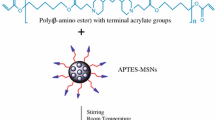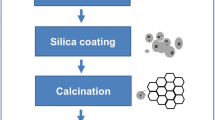Abstract
In this research, mesoporous silica nanoparticles (MSNs) were synthesized and hydrothermally modified with different transition metals, including Co2+, Fe2+, and Zn2+. The obtained samples (M-MSN) were further modified with polyethyleneimine (PEI) to give PEI-M-MSNs. These were studied for adsorption and desorption of siRNA molecules from phosphate-buffered saline (PBS). A direct relationship was observed between the adsorption capacity of each modified MSN sample and its zeta potential. As a result of high cationic nature of the PEI modifier and low ionic radius of Zn2+, PEI-Zn-MSN showed the highest siRNA adsorption capacity. Release of siRNA from the PEI-ZnMSN was just as good as its adsorption (37.6 vs. 42.5 µg/mg). Zeta potential of the samples seems to be a more important factor than their specific surface area. Pure MSN with the BET surface area of 1060 m2 g−1 showed the lowest siRNA adsorption capacity. PEI-Co-MSN, on the other hand, showed an unexpected low BET surface area of 208.9 m2 g−1. The very low adsorption capacity of the PEI-Co-MSN can be attributed to the destruction of the mesoporous framework, caused by the formation of Co3O4 nanoparticles, according to the XRD results. To obtain a sustained release profile, effect of the polyethyleneglycol (PEG) was studied. When a layer of PEG polymer was grafted on the surface, a sustained release profile was achieved and the PEGylated vehicle (PEG-PEI-Zn-MSN) showed tolerable cytotoxicity against normal human fibroblast cells according to the MTT test. The results of the present study may introduce the PEG-PEI-Zn-MSN as a versatile vehicle for efficient siRNA delivery.
















Similar content being viewed by others
References
Akbarzadeh M, Oskuee RK, Gholami L, Mahmoudi A, Malaekeh-Nikouei B (2019) BR2 cell penetrating peptide improved the transfection efficiency of modified polyethyleneimine. J Drug Deliv Sci Technol 53:101154
Asefa T, Tao Z (2012) Mesoporous silica and organosilica materials—Review of their synthesis and organic functionalization. Can J Chem 90:1015–1031
Baeza A, Ruiz-Molina D, Vallet-Regí M (2017) Recent advances in porous nanoparticles for drug delivery in antitumoral applications: inorganic nanoparticles and nanoscale metal-organic frameworks. Expert Opin Drug Deliv 14:783–796
Baghbanbashi M, Pazuki G, Khoee S (2022) One pot silica nanoparticle modification and doxorubicin encapsulation as pH-responsive nanocarriers, applying PEG/lysine aqueous two phase system. J Mol Liq 349:118472
Becicka WM, Bielecki PA, Lorkowski ME, Moon TJ, Zhang Y, Atukorale PU, Covarrubias G, Karathanasis E (2021) The effect of PEGylation on the efficacy and uptake of an immunostimulatory nanoparticle in the tumor immune microenvironment. Nanoscale Adv 3:4961–4972
Chen J, Guo Z, Tian H, Chen X (2016) Production and clinical development of nanoparticles for gene delivery. Mol Ther Methods Clin Dev 3:16023
Dewi HA, Meng F, Sana B, Guo C, Norling B, Chen X, Lim S (2014) Investigation of electron transfer from isolated spinach thylakoids to indium tin oxide. RSC Adv 4(90):48815–48820
Fry JR, Garle MJ, Hammond AH (1988) Choice of acute toxicity measures for comparison of in vivo/in vitro toxicity. Altern Lab Anim 16:175–179
Fujiwara M, Yamamoto F, Okamoto K, Shiokawa K, Nomura R (2005) Adsorption of duplex DNA on mesoporous silicas: possibility of inclusion of DNA into their mesopores. Anal Chem 77:8138–8145
Ganguly A, Ganguli AK (2013) Anisotropic silica mesostructures for DNA encapsulation. Bull Mater Sci 36:329–332
Gomes H, Selvam P, Dapurkar S, Figueiredo J, Faria J (2005) Transition metal (Cu, Cr, and V) modified MCM-41 for the catalytic wet air oxidation of aniline. Microporous Mesoporous Mater 86:287–294
Hajiagha NG, Mahmoudi A, Sazegar MR, Pouramini MM (2019) Synthesis of cobalt-modified MSN as a model enzyme: evaluation of the peroxidatic performance. Microporous Mesoporous Mater 274:43–53
He X-x, Wang K, Tan W, Liu B, Lin X, He C, Li D, Huang S, Li J (2003) Bioconjugated nanoparticles for DNA protection from cleavage. J Am Chem Soc 125:7168–7169
Jiang S, Zhuang J, Wang C, Li J, Yang W (2012) Highly efficient adsorption of DNA on Fe3+–iminodiacetic acid modified silica particles. Colloids Surf A Physicochem Eng Asp 409:143–148
Junquera E, Aicart E (2016) Recent progress in gene therapy to deliver nucleic acids with multivalent cationic vectors. Adv Colloid Interface Sci 233:161–175
Kanamala M, Palmer BD, Jamieson SMF, Wilson WR, Wu Z (2019) Dual pH-sensitive liposomes with low pH-triggered sheddable PEG for enhanced tumor-targeted drug delivery. Nanomed 14:1971–1989
Keasberry N, Yapp C, Idris A (2017) Mesoporous silica nanoparticles as a carrier platform for intracellular delivery of nucleic acids. Biochem Mosc 82:655–662
Kim M-H, Na H-K, Kim Y-K, Ryoo S-R, Cho HS, Lee KE, Jeon H, Ryoo R, Min D-H (2011) Facile synthesis of monodispersed mesoporous silica nanoparticles with ultra large pores and their application in gene delivery. ACS Nano 5:3568–3576
Li M, Hui K, Hui KS, Lee S, Cho Y, Lee H, Zhou W, Cho S, Chao CYH, Li Y (2011) Influence of modification method and transition metal type on the physicochemical properties of, MCM-41 catalysts and their performances in the catalytic ozonation of toluene. Appl Catal B 107:245–252
Li Z, Zhang Y, Feng N (2019) Mesoporous silica nanoparticles: Synthesis, classification, drug loading, pharmacokinetics, biocompatibility, and application in drug delivery. Expert Opin Drug Deliv 16:219–237
Li Z, Mahajan A, Andaraarachchi HP, Lee Y, Kortshagen UR (2021) Water-soluble luminescent silicon nanocrystals by plasma-induced acrylic acid grafting and PEGylation. ACS Appl Bio Mater 5(1):105–112
Lindén J, Larsson M, Kaur S, Nosrati A, Nydén M (2016) Glutaraldehyde‐crosslinking for improved copper absorption selectivity and chemical stability of polyethyleneimine coatings, J Appl Polym Sci 133
Lo K, Chen M, Ho R, Sung H (2009) Pore-Filling Nanoporous Templates from Degradable Block Copolymers for Nanoscale Drug Delivery. ACS Nano 3(9):2660–2666
Ma Z, Guan Y, Liu H (2006) Superparamagnetic silica nanoparticles with immobilized metal affinity ligands for protein adsorption. J Magn Magn Mater 301:469–477
Mardani F, Khorshidi A, Gholampoor S (2019) Sulfonated caspian sea sand: a promising heterogeneous solid acid catalyst in comparison with–SO3H functionalized NiFe2O4@ SiO2@ KIT-6. Chem Select 4:8015–8020
Mosmann T (1986) Rapid colorimetric assay for cellular growth and survival: application to proliferation and cytotoxicity assays. J Immunol Methods 65:55–63
Nakamura T, Mizutani M, Nozaki H, Suzuki N, Yano K (2007) Formation mechanism for monodispersed mesoporous silica spheres and its application to the synthesis of core/shell particles. J Phys Chem C 111:1093–1100
Ortiz-Martinez K, Guerrero-Medina KJ, Roman FR, Hernandez-Maldonado AJ (2015) Transition metal modified mesoporous silica adsorbents with zero microporosity for the adsorption of contaminants of emerging concern (CECs) from aqueous solutions. Chem Eng J 264:152–164
Pena SA, Iyengar R, Eshraghi RS, Bencie N, Mittal J, Aljohani A, Mittal R, Eshraghi AA (2020) Gene therapy for neurological disorders: challenges and recent advancements. J Drug Target 28:111–128
Popova M, Szegedi A, Cherkezova-Zheleva Z, Mitov I, Kostova N, Tsoncheva T (2009) Toluene oxidation on titanium-and iron-modified MCM-41 materials. J Hazard Mater 168:226–232
Prabhakar N, Zhang J, Desai D, Casals E, Gulin-Sarfraz T, Näreoja T, Westermarck J, Rosenholm JM (2016) Stimuli-responsive hybrid nanocarriers developed by controllable integration of hyperbranched PEI with mesoporous silica nanoparticles for sustained intracellular siRNA delivery. Int J Nanomed 11:6591
Sazegar MR, Mahmoudian Sh, Mahmoudi A, Triwahyono S, Jalil AA, Mukti RR, Nazirah K, Nur H, Ghoreishi MK (2016) Catalyzed Claisen-Schmidt reaction by protonated aluminate mesoporous silica nanomaterial focused on the (E)-chalcone synthesis as a biologically active compound. RSC Adv 6(13):11023–11031
Schwarz R, Zitzow E, Fiebig A, Hering S, Humboldt Y, Schoenwaelder N, Kämpfer N, Volkmar K, Hinz B, Kreikemeyer B (2022) PEGylation increases antitumoral activity of arginine deiminase of Streptococcus pyogenes. Appl Microbiol Biotechnol 106:261–271
Shao D, Lu M-m, Zhao Y-w, Zhang F, Tan Y-f, Zheng X, Pan Y, Xiao X-a, Wang Z, Dong W-f (2017) The shape effect of magnetic mesoporous silica nanoparticles on endocytosis, biocompatibility and biodistribution. Acta Biomater 49:531–540
Sun N, Deng C, Liu Y, Zhao X, Tang Y, Liu R, Xia Q, Yan W, Ge G (2014) Optimization of influencing factors of nucleic acid adsorption onto silica-coated magnetic particles: application to viral nucleic acid extraction from serum. J Chromatogr A 1325:31–39
Sundriyal P, Sahu M, Prakash O, Bhattacharya S (2021) Long-term surface modification of PEEK polymer using plasma and PEG silane treatment. Surf Interfaces 25:101253
Tang F, Li L, Chen D (2012) Mesoporous silica nanoparticles: synthesis, biocompatibility and drug delivery. Adv Mater 24:1504–1534
Teo PY, Cheng W, Hedrick JL, Yang YY (2016) Co-delivery of drugs and plasmid DNA for cancer therapy. Adv Drug Deliv Rev 98:41–63
Todorova S, Parvulescu V, Kadinov G, Tenchev K, Somacescu S, Su B-L (2008) Metal states in cobalt-and cobalt–vanadium-modified MCM-41 mesoporous silica catalysts and their activity in selective hydrocarbons oxidation. Microporous Mesoporous Mater 113:22–30
Topuz F, Uyar T (2018) Cyclodextrin-assisted synthesis of tailored mesoporous silica nanoparticles. Beilstein J Nanotechnol 9:693–703
Trofimov AD, Ivanova AA, Zyuzin MV, Timin AS (2018) Porous inorganic carriers based on silica, calcium carbonate and calcium phosphate for controlled/modulated drug delivery: Fresh outlook and future perspectives. Pharmaceutics 10:167
Tsoncheva T, Areva S, Dimitrov M, Paneva D, Mitov I, Linden M, Minchev C (2006) MCM-41 silica modified with copper and iron oxides as catalysts for methanol decomposition. J Mol Catal A Chem 246:118–127
Van Bruggen C, Hexum JK, Tan Z, Dalal RJ, Reineke TM (2019) Nonviral gene delivery with cationic glycopolymers. Acc Chem Res 52:1347–1358
Vathyam R, Wondimu E, Das S, Zhang C, Hayes S, Tao Z, Asefa T (2011) Improving the adsorption and release capacity of organic-functionalized mesoporous materials to drug molecules with temperature and synthetic methods. J Phys Chem C 115:13135–13150
Verma IM, Naldini L, Kafri T, Miyoshi H, Takahashi M, Blömer U, Somia N, Wang L, Gage F (2000) Gene therapy: promises, problems, and prospects, genes and resistance to disease. Springer, pp 147–157
von Baeckmann C, Kählig H, Lindén M, Kleitz F (2021) On the importance of the linking chemistry for the PEGylation of mesoporous silica nanoparticles. J Colloids Interface Sci 589:453–461
Wang K, Kievit FM, Zhang M (2016) Nanoparticles for cancer gene therapy: Recent advances, challenges, and strategies. Pharmacol Res 114:56–66
Zeng H, Little HC, Tiambeng TN, Williams GA, Guan Z (2013) Multifunctional dendronized peptide polymer platform for safe and effective siRNA delivery. J Am Chem Soc 135:4962–4965
Zhang X, Zhang J, Quan G, Yang P, Pan X, Wu C (2017) The serum-resistant transfection evaluation and long-term stability of gene delivery dry powder based on mesoporous silica nanoparticles and polyethyleneimine by freezing-drying. AAPS Pharm Sci Tech 18:1536–1543
Zhang Y, Ren K, Zhang X, Chao Z, Yang Y, Ye D, Dai Z, Liu Y, Ju H (2018) Photo-tearable tape close-wrapped upconversion nanocapsules for near-infrared modulated efficient siRNA delivery and therapy. Biomaterials 163:55–66
Zhou Y, Quan G, Wu Q, Zhang X, Niu B, Wu B, Huang Y, Pan X, Wu C (2018) Mesoporous silica nanoparticles for drug and gene delivery. Acta Pharm Sin B 8:165–177
Acknowledgements
We thank the deputy of the research, Tehran North Branch, Islamic Azad University for support of this study.
Author information
Authors and Affiliations
Corresponding authors
Ethics declarations
Conflict of interest
The authors of this manuscript declare no conflict of interest.
Additional information
Publisher's Note
Springer Nature remains neutral with regard to jurisdictional claims in published maps and institutional affiliations.
Rights and permissions
Springer Nature or its licensor holds exclusive rights to this article under a publishing agreement with the author(s) or other rightsholder(s); author self-archiving of the accepted manuscript version of this article is solely governed by the terms of such publishing agreement and applicable law.
About this article
Cite this article
Badihi, R., Mahmoudi, A., Sazegar, M.R. et al. A study on co-modification of MSNs with some transition metals and polyethyleneimine (PEI) as a versatile strategy for efficient delivery of short oligonucleotides. Chem. Pap. 76, 7023–7035 (2022). https://doi.org/10.1007/s11696-022-02387-7
Received:
Accepted:
Published:
Issue Date:
DOI: https://doi.org/10.1007/s11696-022-02387-7




